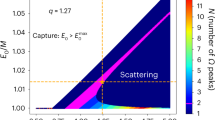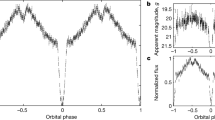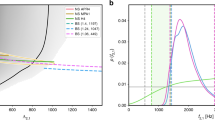Abstract
The general-relativistic phenomenon of spin-induced orbital precession has not yet been observed in strong-field gravity. Gravitational-wave observations of binary black holes (BBHs) are prime candidates, as we expect the astrophysical binary population to contain precessing binaries1,2. Imprints of precession have been investigated in several signals3,4,5, but no definitive identification of orbital precession has been reported in any of the 84 BBH observations so far5,6,7 by the Advanced LIGO and Virgo detectors8,9. Here we report the measurement of strong-field precession in the LIGO–Virgo–Kagra gravitational-wave signal GW200129. The binary’s orbit precesses at a rate ten orders of magnitude faster than previous weak-field measurements from binary pulsars10,11,12,13. We also find that the primary black hole is probably highly spinning. According to current binary population estimates, a GW200129-like signal is extremely unlikely, and therefore presents a direct challenge to many current binary-formation models.
This is a preview of subscription content, access via your institution
Access options
Access Nature and 54 other Nature Portfolio journals
Get Nature+, our best-value online-access subscription
$29.99 / 30 days
cancel any time
Subscribe to this journal
Receive 51 print issues and online access
$199.00 per year
only $3.90 per issue
Buy this article
- Purchase on Springer Link
- Instant access to full article PDF
Prices may be subject to local taxes which are calculated during checkout



Similar content being viewed by others
Data availability
The posterior samples from the analyses performed in this work are available on Zenodo at https://zenodo.org/record/6672460. Public documentation is available at https://data.cardiffgravity.org/GW200129-precession/.
References
Farr, W. M. et al. Distinguishing spin-aligned and isotropic black hole populations with gravitational waves. Nature 548, 426–429 (2017).
Abbott, R. et al. The population of merging compact binaries inferred using gravitational waves through GWTC-3. Preprint at https://arxiv.org/abs/2111.03634 (2021).
Abbott, R. GW190412: observation of a binary-black-hole coalescence with asymmetric masses. Phys. Rev. D 102, 043015 (2020).
Abbott, R. Properties and astrophysical implications of the 150 M⊙ binary black hole merger GW190521. Astrophys. J. Lett. 900, L13 (2020).
Abbott, R. et al. GWTC-3: compact binary coalescences observed by LIGO and Virgo during the second part of the third observing run. Preprint at https://arxiv.org/abs/2111.03606 (2021).
Abbott, B. P. GWTC-1: a gravitational-wave transient catalog of compact binary mergers observed by LIGO and Virgo during thE First and Second Observing Runs. Phys. Rev. X 9, 031040 (2019).
Abbott, R. GWTC-2: compact binary coalescences observed by LIGO and Virgo during the first half of the third observing run. Phys. Rev. X 11, 021053 (2021).
Aasi, J. Advanced LIGO. Class. Quant. Grav. 32, 074001 (2015).
Acernese, F. Advanced Virgo: a second-generation interferometric gravitational wave detector. Class. Quant. Grav. 32, 024001 (2015).
Taylor, J. H. & Weisberg, J. M. A new test of general relativity: gravitational radiation and the binary pulsar PSR 1913+16. Astrophys. J. 253, 908–920 (1982).
Kramer, M. Determination of the geometry of the PSR B1913+16 system by geodetic precession. Astrophys. J. 509, 856–860 (1998).
Burgay, M. An increased estimate of the merger rate of double neutron stars from observations of a highly relativistic system. Nature 426, 531–533 (2003).
Breton, R. P. et al. Relativistic spin precession in the double pulsar. Science 321, 104–107 (2008).
Abbott, B. P. Observation of gravitational waves from a binary black hole merger. Phys. Rev. Lett. 116, 061102 (2016).
Manchester, R. N. Observations and modelling of relativistic spin precession in PSR J1141−6545. Astrophys. J. 710, 1694–1709 (2010).
Fonseca, E., Stairs, I. H. & Thorsett, S. E. A comprehensive study of relativistic gravity using PSR B1534+12. Astrophys. J. 787, 82 (2014).
Desvignes, G. et al. Radio emission from a pulsar’s magnetic pole revealed by general relativity. Science 365, 1013–1017 (2019).
Krishnan, V. V. Lense–Thirring frame dragging induced by a fast-rotating white dwarf in a binary pulsar system. Science 367, 577–580 (2020).
Barker, B. M. & O’Connell, R. F. Gravitational two-body problem with arbitrary masses, spins, and quadrupole moments. Phys. Rev. D 12, 329–335 (1975).
Apostolatos, T. A., Cutler, C., Sussman, G. J. & Thorne, K. S. Spin induced orbital precession and its modulation of the gravitational wave forms from merging binaries. Phys. Rev. D49, 6274–6297 (1994).
Kidder, L. E. Coalescing binary systems of compact objects to postNewtonian 5/2 order. 5. Spin effects. Phys. Rev. D 52, 821–847 (1995).
Pürrer, M., Hannam, M. & Ohme, F. Can we measure individual black-hole spins from gravitational-wave observations? Phys. Rev. D 93, 084042 (2016).
Fairhurst, S., Green, R., Hoy, C., Hannam, M. & Muir, A. Two-harmonic approximation for gravitational waveforms from precessing binaries. Phys. Rev. D 102, 024055 (2020).
Fuller, J. & Ma, L. Most black holes are born very slowly rotating. Astrophys. J. Lett. 881, 1 (2019).
Kimball, C. Evidence for hierarchical black hole mergers in the second LIGO–Virgo gravitational wave catalog. Astrophys. J. Lett. 915, 35 (2021).
Tiwari, V. & Fairhurst, S. The emergence of structure in the binary black hole mass distribution. Astrophys. J. Lett. 913, 19 (2021).
Kalogera, V. Spin orbit misalignment in close binaries with two compact objects. Astrophys. J. 541, 319–328 (2000).
Steinle, N. & Kesden, M. Pathways for producing binary black holes with large misaligned spins in the isolated formation channel. Phys. Rev. D 103, 063032 (2021).
Mandel, I. & de Mink, S. E. Merging binary black holes formed through chemically homogeneous evolution in short-period stellar binaries. Mon. Not. R. Astron. Soc. 458, 2634–2647 (2016).
Tagawa, H., Haiman, Z., Bartos, I. & Kocsis, B. Spin evolution of stellar-mass black hole binaries in active galactic nuclei. Astrophys. J. 899, 26 (2020).
Antonini, F., Rodriguez, C. L., Petrovich, C. & Fischer, C. L. Precessional dynamics of black hole triples: binary mergers with near-zero effective spin. Mon. Not. R. Astron. Soc. 480, 58–62 (2018).
Fairhurst, S., Green, R., Hannam, M. & Hoy, C. When will we observe binary black holes precessing? Phys. Rev. D 102, 041302 (2020).
Advanced LIGO, Advanced Virgo and KAGRA Observing Run Plans (KAGRA Collaboration, LIGO Scientific Collaboration and Virgo Collaboration, 2019).
Rodriguez, C. L., Zevin, M., Pankow, C., Kalogera, V. & Rasio, F. A. Illuminating black hole binary formation channels with spins in advanced ligo. Astrophys. J. Lett. 832, 2 (2016).
Abbott, R. Open data from the first and second observing runs of Advanced LIGO and Advanced Virgo. SoftwareX 13, 100658 (2021).
Varma, V. et al. Surrogate models for precessing binary black hole simulations with unequal masses. Phys. Rev. Res. 1, 033015 (2019).
Veitch, J. Parameter estimation for compact binaries with ground-based gravitational-wave observations using the LALInference software library. Phys. Rev. D 91, 042003 (2015).
Abbott, B. P. Properties of the binary black hole merger GW150914. Phys. Rev. Lett. 116, 241102 (2016).
Green, R. et al. Identifying when precession can be measured in gravitational waveforms. Phys. Rev. D 103, 124023 (2021).
Hoy, C., Mills, C. & Fairhurst, S. Evidence for subdominant multipole moments and precession in merging black-hole-binaries from GWTC-2.1. Phys. Rev. D 106, 023019 (2022).
Smith, R. J. E., Ashton, G., Vajpeyi, A. & Talbot, C. Massively parallel Bayesian inference for transient gravitational-wave astronomy. Mon. Not. R. Astron. Soc. 498, 4492–4502 (2020).
Speagle, J. S. dynesty: a dynamic nested sampling package for estimating Bayesian posteriors and evidences. Mon. Not. R. Astron. Soc. 493, 3132–3158 (2020).
Schmidt, P., Hannam, M., Husa, S. & Ajith, P. Tracking the precession of compact binaries from their gravitational-wave signal. Phys. Rev. D 84, 024046 (2011).
Hamilton, E. et al. Model of gravitational waves from precessing black-hole binaries through merger and ringdown. Phys. Rev. D 104, 124027 (2021).
Islam, T., Field, S. E., Haster, C.-J. & Smith, R. Improved analysis of GW190412 with a precessing numerical relativity surrogate waveform model. Phys. Rev. D 103, 104027 (2021).
Baird, E., Fairhurst, S., Hannam, M. & Murphy, P. Degeneracy between mass and spin in black-hole-binary waveforms. Phys. Rev. D 87, 024035 (2013).
Pratten, G. et al. Setting the cornerstone for a family of models for gravitational waves from compact binaries: The dominant harmonic for nonprecessing quasicircular black holes. Phys. Rev. D 102, 064001 (2020).
García-Quirós, C. et al. Multimode frequency-domain model for the gravitational wave signal from nonprecessing black-hole binaries. Phys. Rev. D 102, 064002 (2020).
Pratten, G. Computationally efficient models for the dominant and subdominant harmonic modes of precessing binary black holes. Phys. Rev. D 103, 104056 (2021).
Ossokine, S. Multipolar effective-one-body waveforms for precessing binary black holes: construction and validation. Phys. Rev. D 102, 044055 (2020).
Biscoveanu, S., Isi, M., Varma, V. & Vitale, S. Measuring the spins of heavy binary black holes. Phys. Rev. D 104, 103018 (2021).
Romero-Shaw, I. M., Lasky, P. D., Thrane, E. & Bustillo, J. C. GW190521: orbital eccentricity and signatures of dynamical formation in a binary black hole merger signal. Astrophys. J. Lett. 903, 5 (2020).
Gayathri, V. et al. Eccentricity estimate for black hole mergers with numerical relativity simulations. Nat. Astron. 6, 344–349 (2022).
Bustillo, J. C., Sanchis-Gual, N., Torres-Forné, A. & Font, J. A. Confusing head-on collisions with precessing intermediate-mass binary black hole mergers. Phys. Rev. Lett. 126, 201101 (2021).
Chatziioannou, K. et al. Measuring the properties of nearly extremal black holes with gravitational waves. Phys. Rev. D 98, 044028 (2018).
Zevin, M., Berry, C. P. L., Coughlin, S., Chatziioannou, K. & Vitale, S. You can’t always get what you want: the impact of prior assumptions on interpreting GW190412. Astrophys. J. Lett. 899, 17 (2020).
Tiwari, V., Fairhurst, S. & Hannam, M. Constraining black-hole spins with gravitational wave observations. Astrophys. J. 868, 140 (2018).
Hoy, C., Fairhurst, S., Hannam, M. & Tiwari, V. Understanding how fast black holes spin by analyzing data from the second gravitational-wave catalogue. Astrophys. J. 928, 75 (2022).
Hunter, J. D. Matplotlib: a 2D graphics environment. Comput. Sci. Eng. 9, 90–95 (2007).
Macleod, D. M., Areeda, J. S., Coughlin, S. B., Massinger, T. J. & Urban, A. L. GWpy: a Python package for gravitational-wave astrophysics. SoftwareX 13, 100657 (2021).
Hoy, C. & Raymond, V. PESummary: the code agnostic Parameter Estimation Summary page builder. SoftwareX 15, 100765 (2021).
LIGO Scientific Collaboration LIGO Algorithm Library—LALSuite (GPL, 2018).
Ashton, G. BILBY: a user-friendly Bayesian inference library for gravitational-wave astronomy. Astrophys. J. Suppl. Ser. 241, 27 (2019).
Romero-Shaw, I. M. Bayesian inference for compact binary coalescences with bilby: validation and application to the first LIGO–Virgo gravitational-wave transient catalogue. Mon. Not. R. Astron. Soc. 499, 3295–3319 (2020).
Travis, E. O. A Guide to NumPy 2nd edn (CreateSpace, 2015).
McKinney, W. Data structures for statistical computing in Python. In Proc. 9th Python in Science Conference (eds van der Walt, S. & Millman, J.) 51–56 (SciPy, 2010).
London, L. & Fauchon-Jones, E. On modeling for Kerr black holes: basis learning, QNM frequencies, and spherical-spheroidal mixing coefficients. Class. Quant. Grav. 36, 235015 (2019).
London, L., Fauchon-Jones, E. & Hamilton, E. Z. Positive software package. Zenodo https://doi.org/10.5281/zenodo.3901856 (2020).
Acknowledgements
We thank T. Dent, S. Ghosh, E. Hamilton, P. Kolitsidou, L. London and F. Ohme for discussions; and K. Riles for guidance during the internal LIGO review process. The authors were supported in part by Science and Technology Facilities Council (STFC) grant ST/V00154X/1 and European Research Council (ERC) Consolidator Grant 647839. Calculations were performed using the supercomputing facilities at Cardiff University operated by Advanced Research Computing at Cardiff (ARCCA) on behalf of the Cardiff Supercomputing Facility and the HPC Wales and Supercomputing Wales (SCW) projects. We acknowledge the support of the latter, which is part-funded by the European Regional Development Fund (ERDF) via the Welsh Government. In part, the computational resources at Cardiff University were also supported by STFC grant ST/I006285/1. We are also grateful for computational resources provided by LIGO Laboratory and supported by National Science Foundation Grants PHY-0757058 and PHY-0823459. This material is based on work supported by NSF’s LIGO Laboratory, which is a major facility fully funded by the National Science Foundation. This research has made use of data, software and/or web tools obtained from the Gravitational Wave Open Science Center (https://www.gw-openscience.org), a service of LIGO Laboratory, the LIGO Scientific Collaboration and the Virgo Collaboration. LIGO is funded by the US National Science Foundation. Virgo is funded by the French Centre National de Recherche Scientifique (CNRS), the Italian Istituto Nazionale della Fisica Nucleare (INFN) and the Dutch Nikhef, with contributions by Polish and Hungarian institutes. Plots were prepared with Matplotlib59, GWpy60 and PESummary61. Parameter estimation was performed with the LALInference37 and LALSimulation libraries within LALSuite62, as well as the BILBY63,64 and PBILBY41 libraries and the DYNESTY nested sampling package42. NumPy65, Scipy66 and Positive67,68 were used during the analysis.
Author information
Authors and Affiliations
Contributions
M.H. initiated and lead the study and writing of the text. C.H. and J.E.T. performed the parameter-estimation calculations on the detector data, and the synthetic injections. J.E.T. performed the mismatch calculations. V.R. and S.F. provided valuable input to the analysis; V.R. verified the PE results and S.F. produced Fig. 3. M.H., C.H., J.E.T., S.F. and V.R. all contributed to the interpretation of the results and writing the paper. Although they did not directly contribute to the results presented here, the other authors contributed to the LVK’s initial understanding of GW200129, which was the foundation of this work.
Corresponding author
Ethics declarations
Competing interests
The authors declare no competing interests.
Peer review
Peer review information
Nature thanks Michael Kesden and the other, anonymous, reviewer(s) for their contribution to the peer review of this work. Peer reviewer reports are available.
Additional information
Publisher’s note Springer Nature remains neutral with regard to jurisdictional claims in published maps and institutional affiliations.
Extended data figures and tables
Extended Data Fig. 1 Mismatches between waveform models and numerical-relativity waveforms.
Mismatches between three waveform models, and five waveforms from numerical-relativity simulations. The simulations were of binaries with mass-ratio 1:2, and varying values of the in-plane spin magnitude on the primary black hole, a1⊥/m1, which is what drives precession. The dotted line shows the accuracy threshold assuming eight degrees of freedom, and the dashed-dotted line the threshold assuming only four degrees of freedom (see text for discussion). Only the NRSur7dq4 is well within the accuracy thresholds for GW200129.
Extended Data Fig. 2 Mismatches between the most accurate waveform model and those used in the LVK analysis.
Mismatches between theoretical signals (calculated using the NRSur7dq4 model) against the PhenomXPHM and SEOBNRv4PHM models. The model parameters are those recovered from our analysis of GW200129, but with a range of values of the primary spin magnitude a1/m1. We see that neither model meets the accuracy thresholds for GW200129 at high spins, but the better agreement of PhenomXPHM is consistent with it recovering results closer to those reported in this work.
Extended Data Fig. 3 Comparison between GW200129 results and those from a model-waveform injection.
One-dimensional posterior distributions for the primary black hole’s spin, a1/m1, and the binary’s mass ratio, q = m2/m1 ≤ 1, from a parameter-estimation analysis of GW200129 in raw detector data starting at 30 Hz, and an idealized zero-noise injection. The main results for the three-detector network (left) are broadly consistent between the real data and the injection. We also find in both the real data and the injection that analysis of a Hanford-Virgo-only analysis (middle) prefers equal-mass binaries and much weaker evidence for precession, while a Livingston-Virgo-only analysis (right) identifies an unequal-mass precessing binary; this can be explained by the lower SNR in Hanford (14.6, vs 21.2 in Livingston), which reduces the measurability of precession.
Supplementary information
Rights and permissions
Springer Nature or its licensor holds exclusive rights to this article under a publishing agreement with the author(s) or other rightsholder(s); author self-archiving of the accepted manuscript version of this article is solely governed by the terms of such publishing agreement and applicable law.
About this article
Cite this article
Hannam, M., Hoy, C., Thompson, J.E. et al. General-relativistic precession in a black-hole binary. Nature 610, 652–655 (2022). https://doi.org/10.1038/s41586-022-05212-z
Received:
Accepted:
Published:
Issue Date:
DOI: https://doi.org/10.1038/s41586-022-05212-z
This article is cited by
-
Why is black hole entropy affected by rotation?
Journal of High Energy Physics (2023)
Comments
By submitting a comment you agree to abide by our Terms and Community Guidelines. If you find something abusive or that does not comply with our terms or guidelines please flag it as inappropriate.



